Chapter
Five Part One
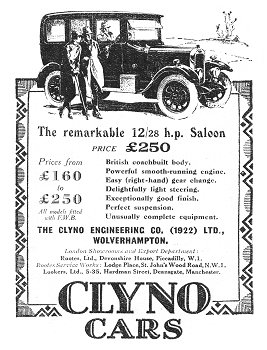 |
Having spent some time considering
the competition side of the Wolverhampton firms, we should
now turn to the vehicles they made to sell to the public. In
1925 Clyno introduced a new model which received an
excellent write up in “Light Car & Cyclecar”.
The car was known as the 13h.p. and
included a four cylinder side valve engine with cylinder
dimensions of 69 x 100mm. Its 3 speed gearbox had right hand
control and along with the spiral bevel rear axle was
designed and manufactured in-house. Features included four
wheel brakes, Dunlop 28” x 4.95” balloon tyres and excellent
bodywork. Two and four seater versions were available as a
tourer, saloon, or fixed and drop head coupe. The new Clyno
was very good value at £245 for the two seater and £298 for
the saloon. The “Royal” continued to be listed at £210 for
the two seater and £38 more for the saloon. |
|
At this time Star
enlarged the 18h.p. side valve engine to 3.3 litres and
designated it the 20/50. The sales literature included an o.h.v.
sports model with four wheel brakes. The Bushbury body plant was
now in operation and production included fabric bodies for the
l8/50 Luna saloon, built by Holbrook and Taylor of nearby Park
Lane. Weymann coachwork was also offered. Star were finding a
ready sale for their commercial vehicles and during 1925
supplied vans to the well known London store Selfridges for
their delivery fleet.
Sunbeam listed only
three models for 1925, the 12/30 listed at £520, the 14/40
at £685, and the 20/60 costing £950. The two large cars had
four wheel brakes and the 20/60 included a six cylinder
engine. All had overhead valves and a three speed gearbox.
At their Walsall Street factory Briton continued to turn out
cars with their popular 9.5h.p. 1,373c.c. o.h.v. engine.
We will now look at
motorcyc1es. The post war boom was over and many of
Wolverhampton motorcycle and car firms had gone to the wall.
Orbit had ceased production during 1924 although someone in
Ranlegh Road was offering spares through to the 1930s.
Olympic had given up in 1923 after introducing a cheap model
under the New Courier name. Wolf also seem to have given up
making motorcycles but would be back as a lightweight
manufacturer. Even after the closures Wolverhampton was
still an important centre of motorcycle production. |
|
A.J.S. and Sunbeam were
still making large quantities of very good machines and Diamond
were building considerable numbers of excellent lightweight
machines at their Vane Street works. The established
manufacturers were now joined by HRD who produced high quality
and sporting machines.
Sunbeam's range had changed little since the previous year
except that drum brakes were now fitted as standard to all
models. From Graiseley, A.J.S. offered a range of seven models
which included two sidecar outfits, both with the well known and
fine 7.99h.p. ‘V’ twin engine. The model G1 sold for £80 and a
de luxe version including dynamo lighting and electric horn was
listed at £98. The top solo model, the G8, with a 498c.c.
overhead valve engine cost £62.10s.0d. (£62.50) and the 350c.c.
version sold for £53. The company’s cheapest machine, the
349c.c. side valve G5 was priced at £44.10s.0d. (£44.50).
|
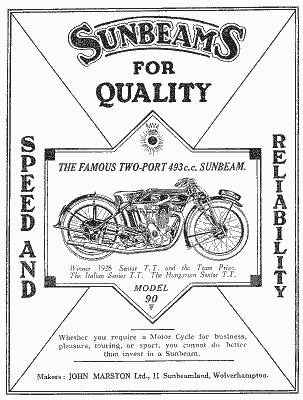 |
| Henry Meadows added a 1.5litre
overhead valve engine to their comprehensive product range.
The four cylinder engine was available in sporting or racing
form and had cylinder dimensions of 69 x l00mm with a
built-in four speed and reverse gearbox. The racing version
had. a higher compression ratio, high lift cams and a
maximum engine speed of over 400r.p.m. The Meadows’ engines
found their way into some of the best British sports cars
and enjoyed many competition successes.
We shall now return to the exciting world of motor and
motorcycle racing and consider the two wheelers. 1924 saw
the birth of the HRD, a machine with sporting tendencies.
With a gaffer like Howard Davies it can be no surprise that
the marque soon appeared on the race tracks. The first
success was in March 1925 when T.L. Morton riding a 490c.c.
HRD won a three lap race at Brooklands with an average speed
of 83.28m.p.h. Success continued when the one
and only Bert le Vack set new British national one way
records in classes ‘C’ and ‘D’, covering the flying mile at
104.44m.p.h. and the flying 5miles at l04.15m.p.h. He also
won a 500c.c. championship race at over 97m.p.h., during
which he had set new standing start 10 mile record at over
96m.p.h. His successes also included the first lap at over
100m.p.h. in a Brooklands race, for which he received the
Buckley Cup. |
|
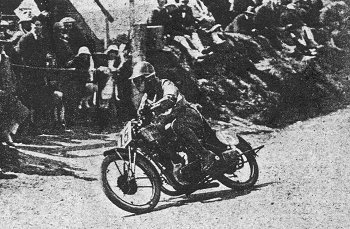
Howard Davies cornering at
Craig-ny-baa. |
HRD made their T.T. debut in 1925
when Howard Davies entered two machines for the Junior and
two for the Senior. They would be ridden by Harry Harris and
Howard Davies himself.
Harris was a good steady rider and team man and with a
little bit of luck was quite capable of being a winner. We
must digress here a little to mention that H.F. Harris's son
Pip would be one of the country’s leading sidecar road
racers in the 1950s and could well have been world champion. |
|
Other Wolverhampton T.T.
entrants were A.J.S. and Sunbeam. Both companies entered five
machines for the Junior race. A.J.S. entered four for the Senior
and Sunbeam entered 8. In the sidecar race they both entered two
machines. A.J.S. riders included Frank Longman, Jimmy Simpson
and George Rowley who was making his T.T. debut. Sunbeam riders
included George Dance, Charlie Dodson, Les Randles and
Italian Achille Varzi.
The practice runs
for the Junior race produced some very fast times with no
less than eight likely winners. The firm favourite was Wal
Handley riding a Rex Acme but Jimmy Simpson and Freddie
Dixon had both achieved excellent times and an exciting race
was in prospect.
Many eyes were on
the new HRD's which were very fast. Their JAP engines had
been breathed on by great rider and wizard tuner Bert le
Vack. Dixon took an early lead in the race with Handley
second and Davies third. During the second lap Dixon retired
and Simpson came into third spot, with Harris and Charlie
Hough on an A.J.S. well up the field. Wal Handley went
through to win at a record average speed of 65.02m.p.h.,
also setting a new lap record of 65.89m.p.h. He finished 3.5
minutes ahead of Davies's HRD with Simpson taking 3rd place,
Hough 4th and Harris 5th. Dodson finished in 8th place and
F.B. Testall came 9th. It now seemed that things were
looking up again for the Wolverhampton machines and there
could be no doubt that HRD was a force to be reckoned with.
Everyone now awaited
the Senior race. Very fast times had been recorded in
practice and it looked to be a very open race. The favourite
was last year’s winner Alec Bennett who would again be
riding a Norton. Right from the word go he took the lead,
with the first lap completed in 33minutes 50 seconds. This
was almost an average speed of 67m.p.h., the fastest ever
run over the Mountain circuit at that time. |
|
Howard Davies lay in 2nd
place, a full 2 minutes 40seconds behind the leader, with Joe
Craig on another Norton 3rd. Bennett’s Norton now began to
develop brake trouble and he had to stop at the pit for
adjustments. Meanwhile Davies took the lead. with a 12 second
advantage over Craig. The heat was now on as Simpson turned the
wick up on his A.J.S. to break the lap record with a time of 32
minutes 50 seconds, an average speed of 68.97m.p.h.
George Dance was
also travelling very fast on his Sunbeam in 3rd place with
Harris 5th on the second HRD. By now Bennett had rectified
the brake problems and was going through the field like a
house on fire and poor George Dance suffered mechanical
trouble and had to retire. At the half way point Howard
Davies had a 38 second lead on his HRD from Joe Craig on a
Norton. A.J.S. riders Jimmy Simpson and Frank Longman were
in 3rd and 4th places with Harry Harris lying 5th.
|
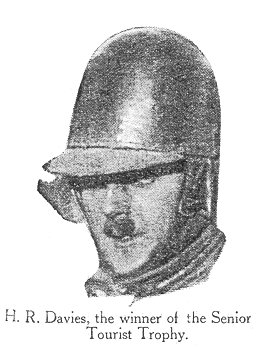 |
|
Lap 4 saw dramatic
changes with both Craig and Simpson dropping out. Harris’s race
also came to an end during the next lap when he retired with
chain trouble. Soon the race was over with Howard Davies coming
in 1st at a record time of 3 hours 25 minutes 25seconds, an
average speed of 66.13m.p.h. Frank Longman came in 2nd on his
A.J.S., three minutes behind Davies with Alec Bennett taking a
well deserved 3rd place. Fastest and record lap fell to A.J.S.
rider Jimmy Simpson who went round in 32 minutes 50 seconds, an
average speed of 68.97m.p.h.
Sunbeam riders did
not do so badly. Amateur T.T. winner Les Randles took 6th
place, Charlie Waterhouse came 11th and Italian Achilli
Varzi was 8th. He would ride in several more T.T.'s on
Sunbeam and Guzzi machines but would then turn to car racing
to become one of the greatest drivers of all time. The
remaining Sunbeam ridden by F.B. Testall finished in 10th
place.
The 1925 T.T. ended
with the Lightweight and Sidecar races. No Wolverhampton
machines took part in the Lightweight Race, but two A.J.S.
and two Sunbeam outfits were entered for the Sidecar Race.
The A.J.S. machines were driven by Jimmy Simpson and Frank
Longman with Competition Manager Graham Walker and George
Cowley for Sunbeam.
Whilst most of the
machines were 600c.c. and the Sunbeams had overhead
camshafts, the AJ's were of only 350c.c. and their riders
were George Rowley and Leo Davenport, of whom we shall be
hearing much more as the story progresses. The practice
period had shown the Douglas’s to be very fast and they were
first favourites to win.
|
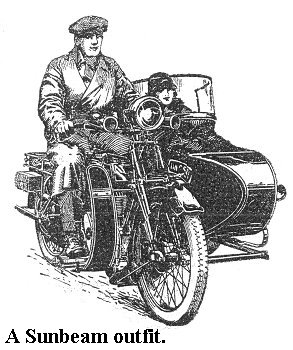 |
Right from the start
they dominated the race with Freddie Dixon leading from
Freddie Hatton and Len Parker, all on the Bristol made
twins. Dixon continued to lead until lap 3 when he retired
with mechanical trouble, which let the Nortons through to
3rd and 4th places, and much to everyone’s surprise the
A.J.S. outfits held 5th and 6th positions.
Hatton soon retired
and Parker went on to win in 2 hours 44 minutes at an
average speed of 55.22m.p.h. The Nortons of AE. Taylor and
George Grinton finished in second and third places with
Frank Longman and Jimmy Simpson in 4th and 5th positions on
their A.J.S. outfits, a very good performance indeed. The
fastest, and record breaking lap had fallen to Freddie Dixon
at 57.18m.p.h.
|
|
Though the sidecar races
had proved to be popular with spectators, the same cannot be
said for the manufacturers, and the 1925 race would be the last
until 1954 when it was over a much shorter course. It would be
1960 before the sidecars were seen on the mountain circuit
again.
The 1925 T.T. week
had been good for Wolverhampton. HRD had done exceedingly
well taking 2nd and 5th places in the Junior and 1st in the
Senior. Howard Davies must have been very happy. After
several disappointing years, riding unsuccessfully on other
manufacturers machines, he had pulled off a spectacular win
in the Senior on a machine of his own design. |
| Whilst thinking of the men, we
can mention George Rowley who became an A.J.S. legend.
His father was machine shop manager at Graiseley, and of
course young George was keen on motorcycles and racing
from the word go. He made his T.T. debut in 1925 as an
A.J.S. works team reserve, riding in both the Junior and
Senior in place of an Australian rider who was injured
in a practice run. He was also Jimmy Simpson’s passenger
in the sidecar race. George Rowley would go on to ride
in races throughout the world, succeeding in all
branches of motorcycling, including trials, sprints,
hill climbs, and motorcycle football. He rode only
A.J.S. machines, and when production ceased in
Wolverhampton he stayed on with the new owners and moved
to their Plumstead Works. At the time the Collier
brothers were not interested in racing, but he persuaded
them to continue with the racing programme and the
A.J.S. name continued to be famous in track events for
many years to come. |
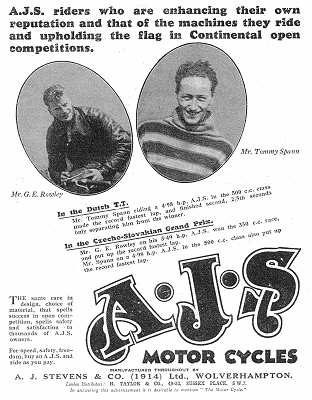 |
|
Rowley rode in his last
T.T. in 1939 and continued working for A.J.S. until his
retirement. His standing in the motorcycle world was
confirmed in the late 1930s when he topped a poll in “Motorcycle
Weekly” magazine to find the most popular competition rider
We will now
return to 1925 and a brief look at the continental races
in which the Wolverhampton machines enjoyed many
successes. To begin with Frank Longman won the 500c.c.
class of the French Grand Prix at Montlehery on an
A.J.S. and AJ's came in 4th and 5th in the 350, and made
a record lap. Longman also set a lap record in the
Belgian G.P. which was marred by the fatal crash of
Billy Hallowell, a young member of the A.J.S. team. His
death was a very sad blow for the Stevens family as
Billy was engaged to be married to Millie Stevens,
George Stevens daughter.
We now move to
Ireland for the Ulster Grand Prix where right from the
start a cracking pace was set by H. Chambers riding an
A.J.S. with J.G. Burney on a Royal Enfield in second
place and J. Forsyth on his Sunbeam third. |
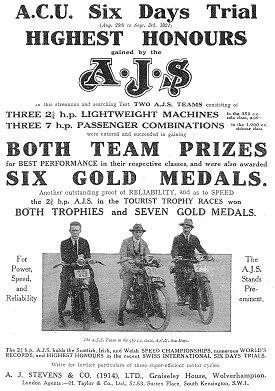 |
Unfortunately Chambers
and Forsyth later retired leaving Burney to go on to win by over
20 minutes from C. Anderson on a DOT. Third place went to J.
Wade on an A.J.S. The 1925 Ulster had not been a good event for
Wolverhampton machinery, but their day would soon come.
Before finishing
with motorcycle racing in 1925 we shall look at the
Amateur T.T. We have seen that Les Randles won the first
two races riding Sunbeams and also noted his placing in
the T.T. At that time it was permissible for a rider to
compete in both T'.T.s and of course Randles was firm
favourite to make it three in a row. During practice he
had been putting in some very fast laps and on the race
day itself he went off like a rocket, breaking the
Amateur T.T. lap record from a standing start, and next
time round breaking it again with a time of 34 minutes
24 seconds. An average speed of 63.9m.p.h., which
by the way would not beaten until 1928 when Tim Hunt on
a Norton pushed it over the 70m.p.h. mark. |
|
On lap 3 the Sunbeam led
by 29 seconds from R. Archibald and C.W. Provis, both on
Nortons. Unfortunately Randles machine soon suffered from clutch
trouble and he had to retire. Archibald took the lead, but this
was not to last as he crashed at Hillberry. Provis now moved
into first place but he retired on lap 4 at Crosby. The
lead was now taken by H.G. Dobbs on a Norton and he went on to
win at an average speed of 59.98m.p.h. Norton riders also filled
2nd and 3rd places with H.Y. Potts finishing 8th on a Sunbeam.
All of the other Sunbeam riders retired as did the four A.J.S.
entries. Two HRD machines also competed. Sunbeam’s reign in the
Amateur T.T. was over and though Wolverhampton made machines
would never again win any of the September races they achieved
some good placings in future years.
During 1925 Freddie
Hicks started his racing career and soon had success riding a
350c.c. A.J.S. at Brooklands. He soon went over to Velocette and
became an expert record breaker as well as a racing man. Later
as we shall learn Hicks returned to the saddle of AJs and came
to work at Graiseley.
Whilst road racing and
record breaking were the glamorous side of motor sport, trials
were very important and the Wolverhampton machines were very
successful in this field. It would be quite impossible here to
attempt to give a full picture of the successes, but we will
mention that in the Christmas trial of the Birmingham Motor
Cycle Club only 10 of the 51 competitors finished and 4 of them
were Sunbeams. They had done well, the best solo performance
being set up by G. Goodman; best sidecar by Alan Watson; whilst
N.P.O. Bradley and R.G. Beesley were awarded gold medals. During
the Year A.J.S. also did very well in the three major
reliability trials; the International Six Days, the ACU Stock
Trial, and the Scottish Six Days. They gained a team prize in
each event and every A.J.S. entered received an award.
We will now take a look
at the sporting achievements of Sunbeam cars in 1925. Early in
the year one C.W. Hamilton had some success at Murinai Beach,
New Zealand with a 1914 T.T. car, winning the 50mile New Zealand
Cup Race at 80m.p.h. and breaking the Australasian 5 mile record
at 100.22m.p.h., which was good going for an 11 year old car.
Incidentally one of the 1914 T.T. Sunbeams is sti1l giving a
good account of itself in vintage sports car racing events at
the present time, 72 years after its first race. |

|

|
Return to
the beginning |
Proceed to
Part 2 |
|